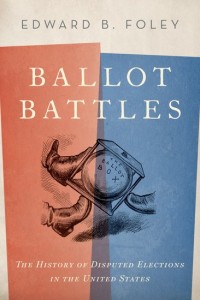The following is the second of five guest posts by Ned Foley of Ohio State, about his new book Ballot Battles: The History of Disputed Elections in the United States:
Theme Two: History shows that the risk of another disputed presidential election is greater than one might think.
Ballot Battles is not just about presidential elections. But as America is on the eve of another presidential election year—and because presidential elections are obviously the most significant ones in our system—it is worth reflecting on the possibility that 2016, like 2000, might end up embroiled in a ballot-counting controversy.
The risk, thankfully, is small. The fact that the nation has suffered only two seriously disputed presidential elections is a sign of that. Still, it significantly understates the risk to say that we’ve encountered only two of these episodes in over 200 years, and so we are probably safe for another century.
First of all, one conclusion reached in Ballot Battles is that 1960 needs to be classified with 1876 and 2000 as presidential elections in which the nation failed to have in place an adequate mechanism to handle a vote-counting dispute. Now, I want to be very clear about what this assertion does not entail. I’m not claiming that Daley stole Illinois for Kennedy, or that LBJ’s machine stole Texas for the Democratic ticket. Instead, what I am asserting is that in 1960 there was no system in place, especially in Texas, by which Nixon would have been able to get a fair recount if he had asked for one. Nixon was a practical politician; he conceded because he knew he did not have a chance for a fair fight over allegations that a proper count of valid (and only valid) ballots would show that he had won both Illinois and Texas—and thus the White House that year. Given that there was no mechanism for a fair recount in place, Nixon’s concession to Kennedy cannot be taken as evidence that the system worked. Instead, it was just capitulation to the reality that America still lacked an adequate system for counting ballots in a close presidential election.
With this sobering assessment of 1960 in mind, the historical numbers start to look a little different. Rather than only two failed presidential elections—in terms of having an adequate ballot-counting system in place—there are three. Moreover, two of these three failures occurred within a span of forty years. That’s roughly a failure rate of two out of every ten quadrennial elections. Especially when considers that this forty-year span is recent rather than distant history, that failure rate is uncomfortably high.
Add to these three failures the “near misses” when the nation narrowly escaped seriously disputed presidential elections. Most Americans today are blissfully unaware of the fact that in both 1884 and 1916 the outcome of the presidential election remained unsettled for a couple of weeks, while lawyers closely scrutinized ballots in the way that they had in 1876 and would again in 2000. The good news is that in neither 1884 nor 1916 did that scrutiny produce evidence of problems that would have been worthy of a more protracted fight. But it was not for lack of looking hard for something to fight on about.
To invoke contemporary terminology, the “margin of litigation” was much narrower in 1884 and 1916, because the pivotal states those years (New York in 1884, California in 1916) ran their elections well enough to withstand a margin of victory of a thousand votes or so. Had the pivotal state been Florida, as it was in 1876 (actually one of four pivotal states that year) or would be again in 2000, lawyers likely could have fought on for weeks or months over a margin of that magnitude. Thus, 1884 and 1916 were years in which the proverbial “killer asteroid” came awfully close to hitting planet Earth, but fortunately passed by without an impact—although today the idea of waiting two weeks for a concession in a presidential election, while the lawyers looked closely ballots, would be viewed as a calamity in and of itself.
1884, moreover, was the closest of a trilogy of three very close presidential elections in the 1880s, all turning on New York. It was like asteroids coming fairly close each time, but thankfully not quite close enough, after a big one had hit in 1876. Some political scientists say that we are currently living through an era of hyper-polarized, hyper-competitive politics not dissimilar to the 1880s. If so, it’s like planet Earth passing through a more dangerous patch of the asteroid belt; our orbit took us through this tricky patch before and now we’re going through it again.
I don’t want to overstate the risk of a seriously disputed presidential election. Even in our current political conditions, it’s still unlikely. But just as a “killer asteroid” would be a monumental calamity although a low-risk proposition, so too another disputed presidential election like 2000 or, even worse, 1876. The consequences are bad enough that they are very much worth trying to avoid even if the probability of them happening is mercifully small.
